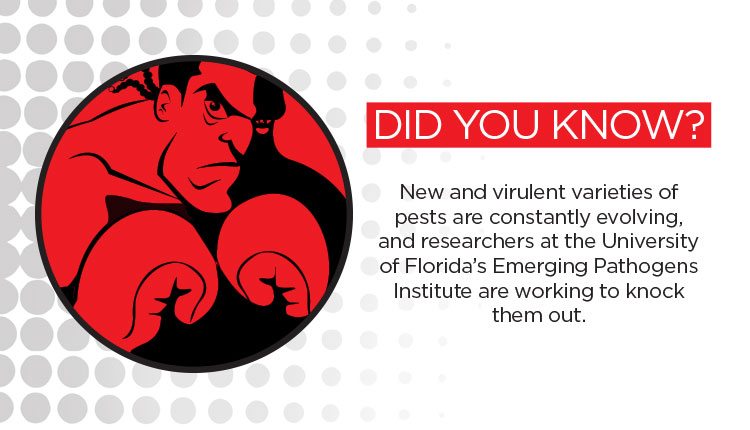As global trade expands and the climate changes, experts predict the battle against pathogens will only intensify.
Since the dawn of agriculture, pests and diseases have challenged humanity’s ability to feed a growing population. Plant pathogens such as fungi, bacteria, insects and other organisms that cause plant diseases are endemic to all of our planet’s land masses and frequently cause havoc with man’s efforts to produce crops.
The movement of pathogens locally, regionally and globally is expected to increase because of increasing trade, the international movement of seed and plant propagated material, and climate change. According to the Food and Agriculture Organization (FAO) of the United Nations, the spread of transboundary plant pests and diseases has increased dramatically in recent years. The FAO shares that in addition to globalization, trade and climate change, reduced resilience in production systems due to decades of agricultural intensification also plays a part.
Around the world, locusts, armyworm, fruit flies, banana diseases, cassava diseases and wheat rusts are among the most destructive plant pests. A host of other foliar, root and stem diseases, including the troublesome citrus greening and laurel wilt, provide monumental obstacles to the production of optimal yields.
Seed companies, chemical companies, governments and universities mount a significant counter offensive in the war against plant pathogens. Helping lead the charge are plant pathologists whose research on plant diseases and their movements aid in the search for solutions and identification of pathogens that could be future problems.
A cadre of these plant pathologists can be found at the University of Florida’s Emerging Pathogens Institute. The Emerging Pathogens Institute fuses key disciplines to develop research, education and outreach capabilities designed to preserve Florida’s health and economy, and to prevent or contain new and re-emerging diseases.
Following the Pathways
One of the current studies of economic importance underway in Florida involves gummy stem blight, a big problem for watermelon and other cucurbit producers. Caused by the fungus Didymella bryoniae, gummy stem blight was first reported in 1891 in France. It is common in the southern United States and in subtropical and tropical areas of the world. Unfortunately, D. bryoniae has developed some resistance to fungicide.
University of Florida plant pathologists Nicholas Dufault and Mathews Paret have been working together with collaborators in China in an effort to understand the evolution of fungicide resistance in D. bryoniae in the United States.
“We are working with our Chinese collaborators to try and understand how pathogens can move through watermelon seed worldwide and how the movement of isolates from one region to another can influence fungicide resistance in the United States,” Paret says. “Most of the watermelon seeds used in U.S. production systems are imported from six countries, one of which is China.”
D. bryoniae is known as a seed borne pathogen and Dufault and Paret are trying to understand where it comes from and what the future risks might be from increased fungicide resistance.
Paret, Dufault and other Florida colleagues are also investigating the possibility of another seedborne disease in watermelon caused by Pseudomonas syringae. For the first time in the spring of 2013, a massive outbreak of P. syringae occurred in watermelon in Florida.
“Our first thought was that this looked like angular leaf spot of cucurbits, but what we found out was that we had a huge influx of a strain of Pseudomonas that is genetically different from angular leaf spot of cucurbits that can infect watermelons, squash, Kamloops and pumpkin,” Paret says. “We are looking at where this Pseudomonas syringae strain is coming from. Working with a seed company in the Netherlands, we have learned that this strain of P. syringae is seedborne in zucchini there. We are working to see at what level our strains could potentially be seedborne.”
Researchers in Florida are also looking at water and transplant houses as potential sources of pathogenic inoculums.
“It is always important to know where your inoculum source is coming from,” says Jeffrey Jones, director of the Southern Plant Diagnostic Network at the University of Florida. “If the inoculum is coming from vegetative material, seed or is just endemic to the location, the source is a concern and needs to be eliminated.”
The mission of the Southern Plant Diagnostic Network is to enhance national agricultural security by quickly detecting introduced pests and pathogens. This is achieved through a functional nationwide network of public agricultural institutions with a cohesive, distributed system to quickly detect high consequence, biological pests and pathogens into U.S. agricultural and natural ecosystems, by providing means for quick identifications and establishing protocols for immediate reporting to appropriate responders and decision-makers.
The goal of the network is to support a secure regional network for the detection and diagnosis of plant health problems, extend and support sound public notices, implement rapid and accurate diagnoses and response strategies, and provide leadership and training.
New virulent varieties of pests are constantly evolving, D.P. Weber and others of Exeter University wrote last year in Global Ecology and Biogeography. “Their emergence is favored by increased sizes of pest populations and their rapid life cycles … Hope lies in the implementation of robust plant protection strategies and biosecurity measures, particularly in the developing world. Whether such precautions can slow or stop this process remains to be seen,” the authors report.
More than one-tenth of all pests have reached more than half the countries that grow their hosts, Weber says. If current trends continue, many important crop producing countries will be fully saturated with pests by the middle of the century.
“While dispersal increases with host range overall, fungi have the narrowest host range, but are the most widely dispersed group,” Weber says. “The global dispersal of some pests has been rapid, but pest assemblages remain strongly regionalized and follow the distributions of their hosts.”
Erica Goss, plant pathologist specializing in pathogen genetics at the University of Florida, and a team of scientists have been studying the global spread of species of Xanthomonas gardneri, which causes bacterial spot of tomato and pepper plants.
“International trade in seeds is likely affecting distribution of all four bacterial spot species,” Goss and the research team reported in the February 2015 edition of the journal Applied and Environmental Microbiology. “It is notable that in Ethiopia, Nigeria, Tanzania and the SWIO islands, three or more different species are found within tomato-growing regions, whereas in the United States, there appears to be a single dominant species in each region.”
Goss says the presence of multiple species might be due to the import of seeds or plant material from multiple sources, a hypothesis that needs to be tested.
Climate Change and Pathogen Movement
— D.P. Weber
Rising annual mean temperatures are changing the global climate with significant effects on people and the environments they inhabit. Climatologists report that the increasing severity of weather will continue into the foreseeable future.
The U.S. Department of Agriculture (USDA) states in a report entitled Climate Change and Agriculture: Effects and Adaptation that while U.S. agriculture and resource management have long histories of successful adaptation to climate variability, the accelerating pace and intensity of climate change presents new challenges. USDA reports that climate change will exacerbate the stresses already occurring from insects and disease. Increases in the incidence of extreme weather events will have an increasing influence on agricultural productivity.
During the next 25 years, USDA adds, the effects of climate change on agricultural production and economic outcomes for both producers and consumers in the U.S. are expected to be mixed, depending on regional conditions. Beyond 2050, changes are expected to include shifts in crop production areas, increases in pest control expenses, and greater disease prevalence.
While tourists and commercial plant imports from around the world have the potential to carry pathogens to the U.S. from other countries, hurricanes add to the problem as wind-borne pathogens can appear or reappear from the Caribbean and Latin America.
“Differences in weather patterns can make pathogens more prevalent,” says Jeffrey Jones. “If you have more storms with lots of wind, you are going to see pathogens move greater distances.”
Weber adds that despite ongoing dispersal of crop pests and pathogens, the degree of biotic homogenization of the globe remains moderate and regionally constrained, but is growing. “Fungal pathogens lead the global invasion of agriculture despite their more restricted host range,” he says. “Climate change is likely to influence future distributions. Improved surveillance would reveal greater levels of invasion, particularly in developing countries.”
In 2014, the USDA Animal and Plant Health Inspection Service (APHIS) adopted a Climate Change Adaptation Plan in order to be ready for increasing challenges from pests and diseases. The plan states that climate change will influence the level of risk to food security and human health associated with a suite of animal and plant diseases, invasive species and agricultural pests. Changes in environmental conditions will increase the likelihood of shifts in the distribution and nature of current domestic diseases and pests, as well as influence the dynamics of invasion and establishment of exotic disease and pests.
The APHIS plan reports that empirical evidence has demonstrated that short term climate disruptions (e.g. drought, heat, and hurricanes) can strongly influence pest and disease incursion. These disruptions sometimes exacerbate pest pressure; however, pest pressure also can be minimized. Climate change is already starting to influence invasion biology, pest/disease epidemiology, and ecosystem dynamics, which can influence not only the likelihood of arrival, but also the potential for establishment and spread.
APHIS does not anticipate that climate change will require a modification of its regulatory authority. However, APHIS believes climate change will likely require new regulations and policies as well as innovative, non-regulatory approaches to address new or shifting pest and disease scenarios.
“[New virulent varieties of pests] emergence is favored by increased sizes of pest populations and their rapid life cycles … Hope lies in the implementation of robust plant protection strategies and biosecurity measures, particularly in the developing world.”
— D.P. Weber
Efforts to Manage
With the global climate changing at a rapid pace, plant pathogens will likely find it easier to follow both traditional and new pathways to additional environments. The global trade of plant of plant products has increased at an unprecedented rate in recent decades, and will continue to expand in the coming years, expanding pathways for plant pathogens to find new hosts.
Writing in the European Journal of Plant Pathology, S. Savary and B.M Cooke noted that plant disease epidemiologists have become experts in assessing the risk of irruption of novel pathogens in plant communities.
“The consequences of plant pathogen transport are many; on local performances of spontaneous ecosystems and agricultural ecosystems; on farmers’ livelihoods; and on local, national and regional economies,” they write.
Can the sciences of plant pathology and plant epidemiology, coupled with advances in plant microbiology and genetics, close the pathways for pathogens and prevent crop disease disasters? Not likely. But rigorous and vigorous efforts to monitor pathways and control diseases might make crop production a little more manageable in this changing world.














